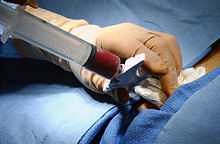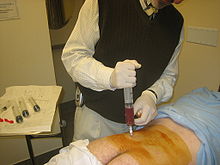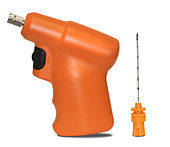- Bone marrow examination
-
Bone marrow examination Diagnostics 
A Wright's stained bone marrow aspirate smear from a patient with leukemia.MeSH D001856 Bone marrow examination refers to the pathologic analysis of samples of bone marrow obtained by bone marrow biopsy (often called a trephine biopsy) and bone marrow aspiration. Bone marrow examination is used in the diagnosis of a number of conditions, including leukemia, multiple myeloma, lymphoma, anemia, and pancytopenia. The bone marrow produces the cellular elements of the blood, including platelets, red blood cells and white blood cells. While much information can be gleaned by testing the blood itself (drawn from a vein by phlebotomy), it is sometimes necessary to examine the source of the blood cells in the bone marrow to obtain more information on hematopoiesis; this is the role of bone marrow aspiration and biopsy.
Contents
Components of the procedure
Bone marrow samples can be obtained by aspiration and trephine biopsy. Sometimes, a bone marrow examination will include both an aspirate and a biopsy. The aspirate yields semi-liquid bone marrow, which can be examined by a pathologist under a light microscope as well as analyzed by flow cytometry, chromosome analysis, or polymerase chain reaction (PCR). Frequently, a trephine biopsy is also obtained, which yields a narrow, cylindrically shaped solid piece of bone marrow, 2mm wide and 2 cm long (80 μL), which is examined microscopically (sometimes with the aid of immunohistochemistry) for cellularity and infiltrative processes. An aspiration, using a 20 mL syringe, yields approximately 300 μL of bone marrow.[1] A volume greater than 300 μL is not recommended, since it may dilute the sample with peripheral blood.[1]
Comparison Aspiration Biopsy Advantages - Fast
- Gives relative quantity of different cell types
- Gives material to further study, e.g. molecular genetics and flow cytometry
- Gives cell and stroma constitution
- Represents all cells
- Explains cause of "dry tap" (aspiration gives no blood cells)
Drawbacks Doesn't represent all cells Slow processing Aspiration doesn't always represent all cells since, as some such as lymphoma stick to the trabecula, and would thus be missed by a simple aspiration.
Site of procedure
Bone marrow aspiration and trephine biopsy are usually performed on the back of the hipbone, or posterior iliac crest. However, an aspirate can also be obtained from the sternum (breastbone). A trephine biopsy should never be performed on the sternum, due to the risk of injury to blood vessels, lungs or the heart.
How the test is performed
A bone marrow biopsy may be done in a health care provider's office or in a hospital. Informed consent for the procedure is typically required. The patient is asked to lie on his or her abdomen (prone position) or on his/her side (lateral decubitus position). The skin is cleansed, and a local anesthetic such as lidocaine is injected to numb the area. Patients may also be pretreated with analgesics and/or anti-anxiety medications, although this is not a routine practice.
Typically, the aspirate is performed first. An aspirate needle is inserted through the skin using manual pressure and force until it abuts the bone. Then, with a twisting motion of clinician's hand and wrist, the needle is advanced through the bony cortex (the hard outer layer of the bone) and into the marrow cavity. Once the needle is in the marrow cavity, a syringe is attached and used to aspirate ("suck out") liquid bone marrow. A twisting motion is performed during the aspiration to avoid excess content of blood in the sample, which might be the case if an excessively large sample from one single point is taken.
Subsequently, the biopsy is performed if indicated. A different, larger trephine needle is inserted and anchored in the bony cortex. The needle is then advanced with a twisting motion and rotated to obtain a solid piece of bone marrow. This piece is then removed along with the needle. The entire procedure, once preparation is complete, typically takes 10–15 minutes.
If several samples are taken, the needle is removed between the samples to avoid blood coagulation.
In March of 2010, Vidacare Corporation introduced a new technology to facilitate faster and easier insertion when compared to manual insertions with comparable or better core sample quality.[2][3][4] The OnControl™ Bone Marrow Biopsy and Aspiration System provides the first advance in bone marrow biopsy and aspiration procedures in over 50 years by combining a specially designed needle with a powered driver to obtain high quality core samples.Validation testing completed prior to the product’s launch on the OnControl™ System showed the following results[5]:
Mean length of core sample of 1.32 cm, Median time to core extraction of 81 seconds, Needle insertion success rate of 94%, Biopsy core acquisition success rate of 90%, Zero complications.
In addition, an article dated April 19, 2010 published in the Journal of Clinical Pathology (Swords, Ronan, et al.)[6] made the following conclusion about the System: “As clinicians, we feel that the speed and ease of use of this new powered system could change the way that bone marrow aspiration and biopsy is carried out in the future, particularly in large centres where this procedure is commonly performed.”
After the procedure
After the procedure is complete, the patient is typically asked to lie flat for 5–10 minutes to provide pressure over the procedure site. After that, assuming no bleeding is observed, the patient can get up and go about their normal activities. Paracetamol (acetaminophen) or other simple analgesics can be used to ease soreness, which is common for 2–3 days after the procedure. Any worsening pain, redness, fever, bleeding or swelling may suggest a complication. Patients are also advised to avoid washing the procedure site for at least 24 hours after the procedure is completed.
Contraindications
There are few contraindications to bone marrow examination. The only absolute reason to avoid performing a bone marrow examination is the presence of a severe bleeding disorder which may lead to serious bleeding after the procedure. If there is a skin or soft tissue infection over the hip, a different site should be chosen for bone marrow examination. Bone marrow aspiration and biopsy can be safely performed even in the setting of extreme thrombocytopenia (low platelet count).
Complications
While mild soreness lasting 12–24 hours is common after a bone marrow examination, serious complications are extremely rare. In a large review, an estimated 55,000 bone marrow examinations were performed, with 26 serious adverse events (0.05%), including one fatality.[7] The same author collected data on over 19,000 bone marrow examinations performed in the United Kingdom in 2003, and found 16 adverse events (0.08% of total procedures), the most common of which was bleeding. In this report, complications, while rare, were serious in individual cases.[8]
References
- ^ a b eMedicine Specialties > Hematology > Diagnostic Procedures > Bone Marrow Aspiration and Biopsy Article Last Updated: Apr 7, 2008
- ^ Lichtman,, Marshall A. , et al. 6th Edition Williams Manual of Hematology. McGraw-Hill, 2003. Print
- ^ San Antonio Business Journal – October 22, 2009 http://www.bizjournals.com/sanantonio/stories/2009/10/19/daily30.html?ana=fro m_rss&utm_source=feedburner&utm_medium=feed&utm_campaign=Feed%3A+ bizj_sanantonio+%28San+Antonio+Business+Journal%29&utm_content=Bloglin es March
- ^ San Antonio Express News - November 23, 2009 http://www.mysanantonio.com/business/local/Vidacare_set_to_launch_biopsy_to ol.html
- ^ Medgadget – March 4, 2010 http://www.medgadget.com/archives/2010/03/vidacares_oncontrol_marrow_aspir ation_and_biopsy_system.html
- ^ Swords Ronan (2010). “Rotary powered device for bone marrow aspiration and biopsy yields excellent specimens quickly and efficiently”.
- ^ Bain BJ (2003). "Bone marrow biopsy morbidity and mortality". Br. J. Haematol. 121 (6): 949–51. doi:10.1046/j.1365-2141.2003.04329.x. PMID 12786808.
- ^ Bain BJ (2005). "Bone marrow biopsy morbidity: review of 2003". J. Clin. Pathol. 58 (4): 406–8. doi:10.1136/jcp.2004.022178. PMC 1770618. PMID 15790706. http://www.pubmedcentral.nih.gov/articlerender.fcgi?tool=pmcentrez&artid=1770618.
External links
Categories:- Medical tests
- Hematology
Wikimedia Foundation. 2010.




